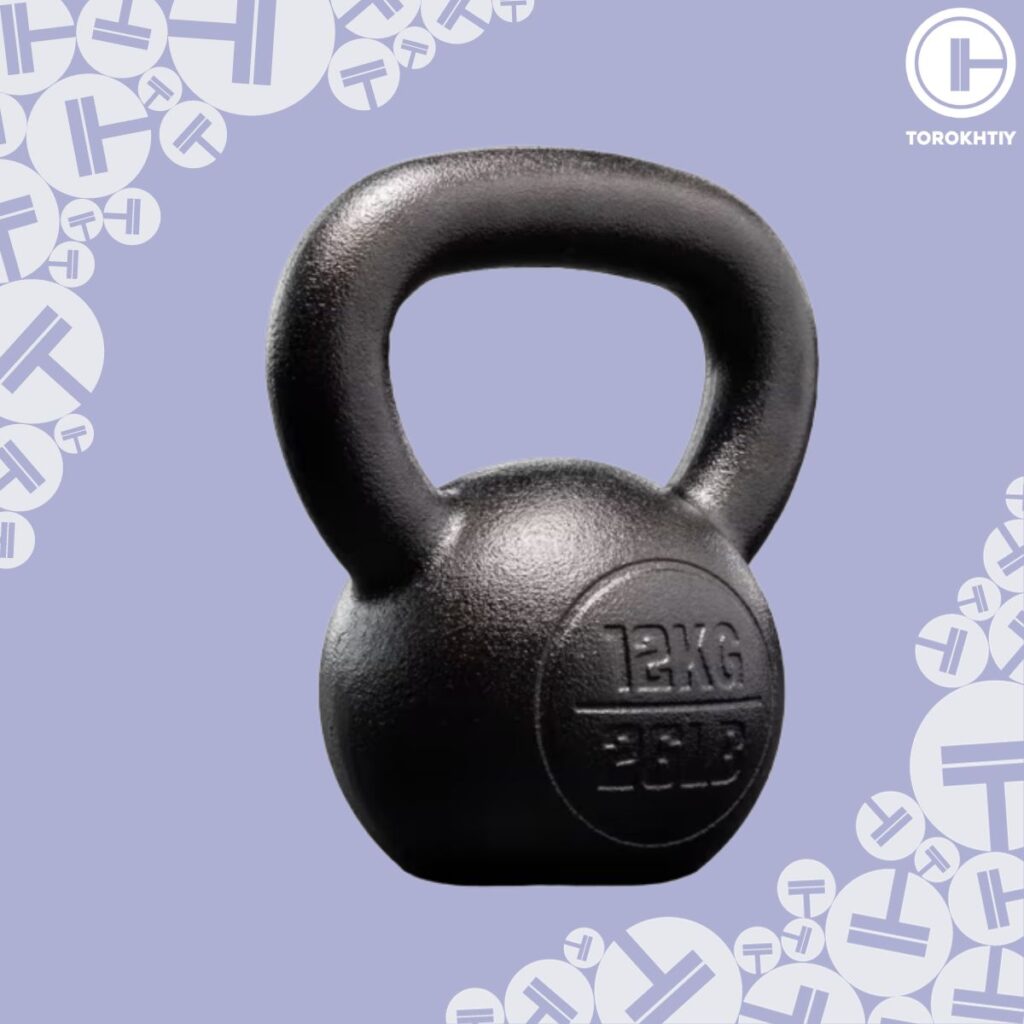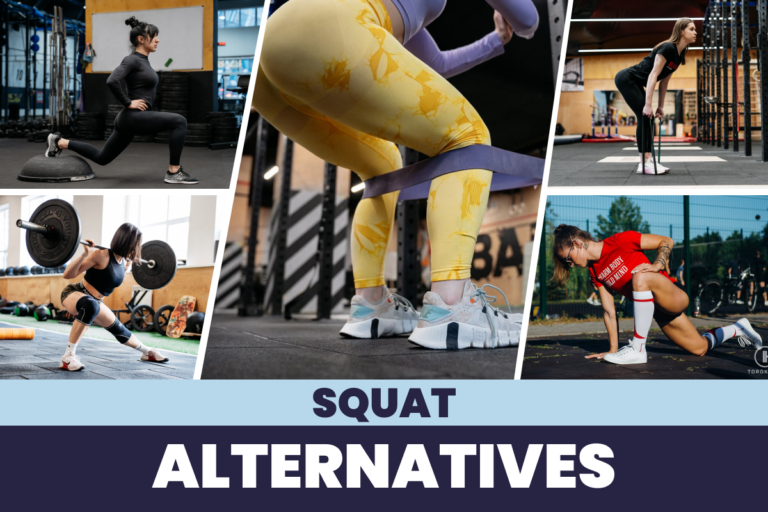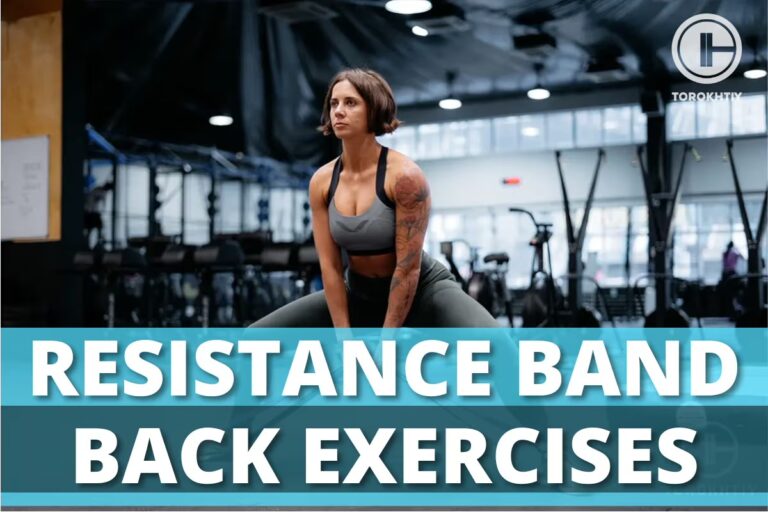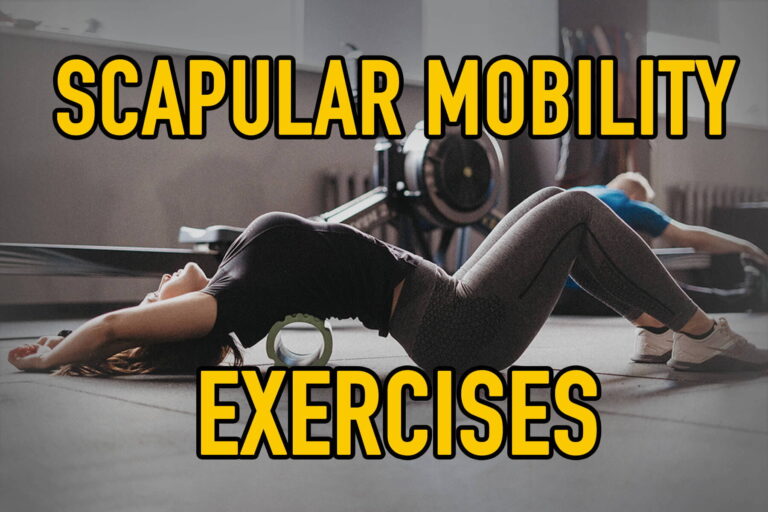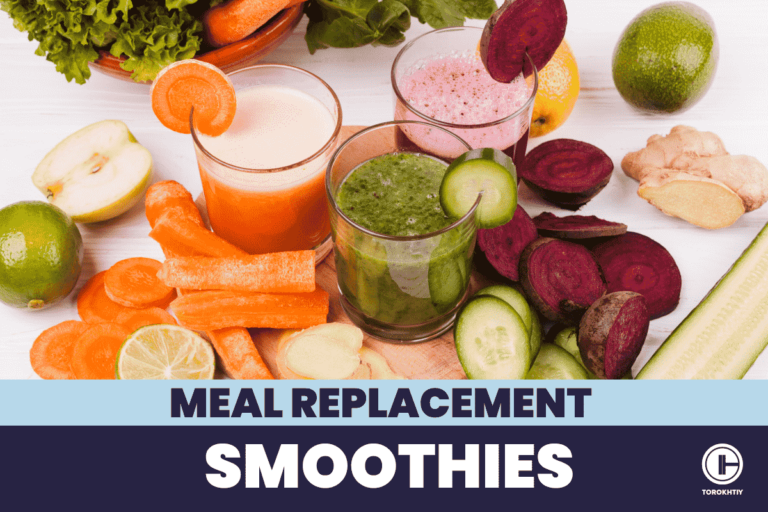10 Benefits of Kettlebell Swings: Muscles Worked + Workout Tips
A kettlebell resembles a cannonball with a handle at the top. It’s quite different from weight room classics like dumbbells and barbells, as the center of mass hangs beyond the grip, thus suitable for swings.
Originated in Russia as early as the 18th century, kettlebells have become wildly popular around the world for full-body functional workouts.
Let’s discuss the benefits of kettlebell swings and how to do them right.
What are the benefits of Kettlebell Swings? The benefits of kettlebell swings range from full-body strength gains and cardiorespiratory fitness to improved balance and coordination. They’re quick, convenient, and adaptable. Plus, they carry low impact and injury risks.
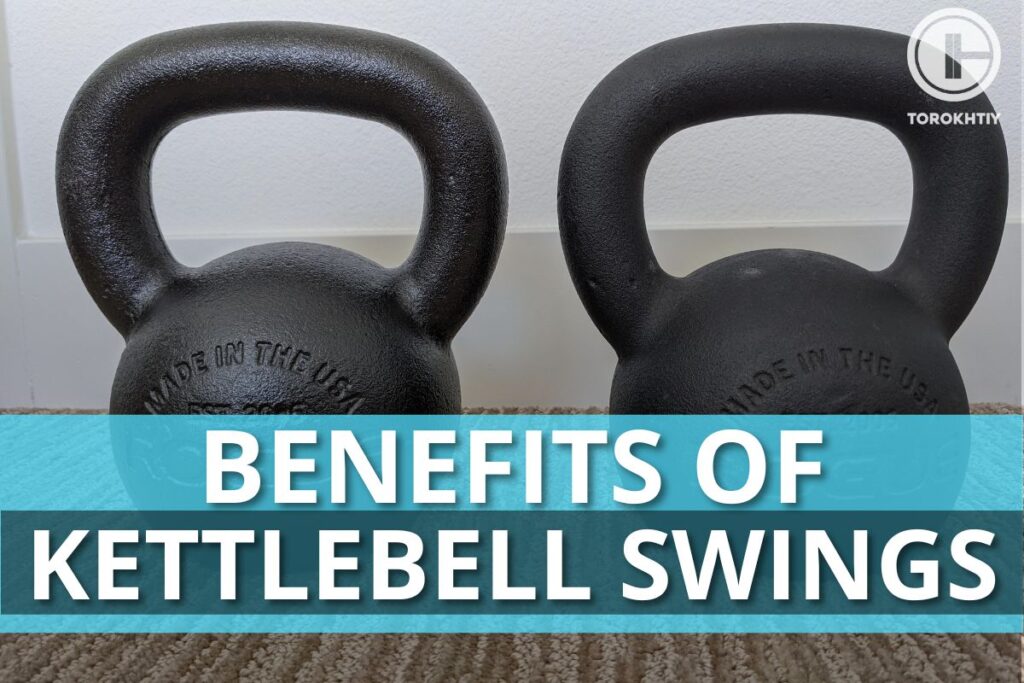
What Muscles Do Kettlebell Swings Work?
First, consider what type of exercise is kettlebell swing. It’s a ballistic movement where you oscillate the weight from between the thighs to the chest level in a pendulum motion. The effort is mainly concentric because gravity assists most of the eccentric part of KB swings.
It’s a quick total-body fitness solution designed to work the entire posterior chain. It includes muscles along the backside of the body: lumbar extensors, glutes, hamstrings, and calves. A healthy posterior chain is crucial for performance, physique, postural stability, and injury prevention in all walks of life. Here are the set of muscles you get to activate during KB swings.
1. Lower Body
The major muscles worked from the bottom of the swing to the top phase are the hamstrings and glutes. Glutes – being the main hip extensors – remain active throughout the movement.
There are multiple styles to perform the swing. If you want maximum engagement of hams, stick with the much touted hip hinge style. Although you don’t squat to pick up the bell, quads aren’t entirely ignored along the hip drive.
Kettlebell swings maintain a stable ground reaction force, but they bring little focus to calves. Due to the limited ankle moment, it’s not the best exercise for calf development, obviously not a substitute for calf raises.
2. The Midsection
With any standing exercise, the core has to anchor and stabilize the movement. The same is true for kettlebell training, which improves core strength and endurance.
Not to the same extent, but swings engage your abs and obliques nicely as well. Both one-handed and two-handed variations are good for training abdominal and core muscles. As the load and ground reaction force increase, you can continue strengthening your hip and trunk musculature.
3. Upper Body
Kettlebells do wonders for the back. They largely emphasize erector spinae. These large, deep muscles flank the vertebral column. They help you turn, extend, and straighten your back. Spinal erectors, glutes, core, and upper back muscles all help maintain a stable posture.
Additionally, trapezius and rhomboid muscles get all riled up. These elevate, retract, and depress the scapula using their upper, middle, and lower fibers, respectively. You’ll thus notice engagement of shoulders, arms, and forearms, which aren’t part of the posterior chain.
All in all – it seems fun kettlebell swings make an efficient and effective training choice, engaging various muscles in a limited time. The American Council on Exercise divides muscles involved into two sections: prime movers and synergists.
Muscles responsible for actual move of the hip extension are placed as prime movers, i.e., glutes and hamstrings. The rest play a synergistic role assisting and stabilizing the movement. These include your calves, abs, delts, quads, etc.
What Are the Benefits of Kettlebell Swings?
Kettlebells are now integral to exercise programs for elite athletes, older adults, military personnel, and diverse patient groups. There are multiple kettlebell swing benefits for general strength and conditioning. Despite a smaller number of studies looking at this particular exercise, you’re sure to reap the following benefits.
✅ Muscle Building
Any form of resistance can potentially build muscles as long as the application is correct and you can progressively overload (not mentioning proper rest and nutrition).
Dr. Brad Schoenfeld proposed three mechanistic theories for muscle growth: mechanical tension, muscle damage, and metabolic stress. Barbell training is the industry standard. Kettlebell swings primarily stress your lower body and core. They won’t puff you up as elite bodybuilders. Still, you can expect substantial strength and muscle gains.
✅ Explosive Strength
The purpose of kettlebell swings is the one you choose. For example, heavier bells improve strength while faster and lighter swings shore up the endurance. You can train to improve speed, strength, cardio and more.
One study showed that maximal and explosive strength improvements were comparable between KB swings and jump squats. If your sports involve activities like skipping and sprinting, you can benefit from including KB swings in your routine.
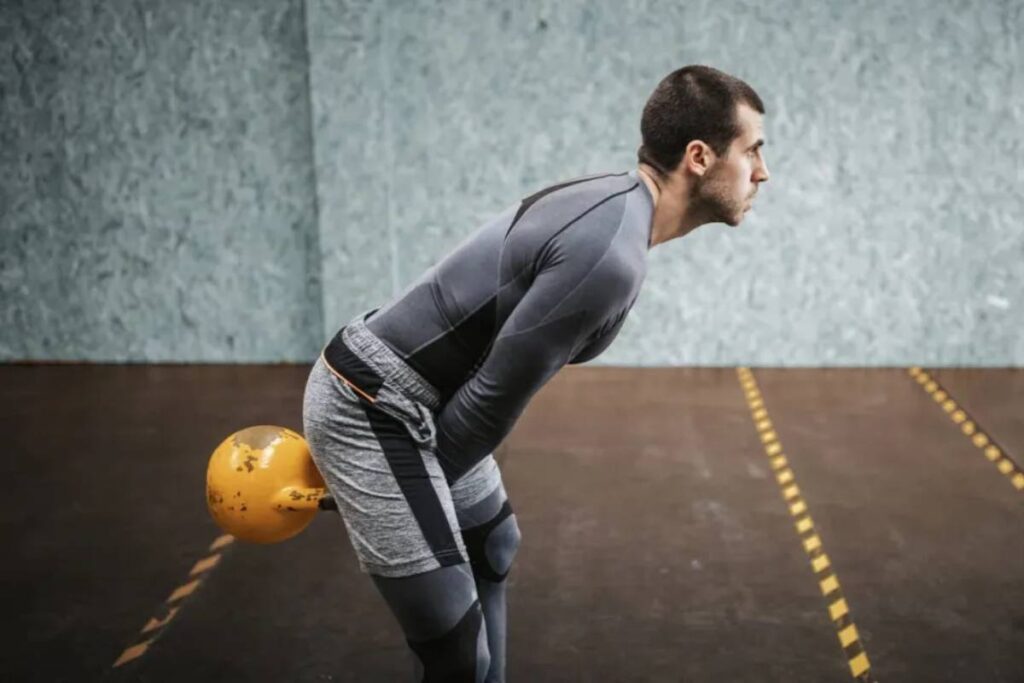
✅ Cardio Boost
Once you modify your weight training, you’ll soon wonder: are kettlebell swings cardio or strength? Why not both?
Kettlebell exercises fuse elements of dynamic training, including aerobic/anaerobic metabolism. KB swings and treadmill sprints can elevate your heart rate and oxygen uptake to the same level. You can even burn as much as 20 calories in one minute.
✅ Low Impact
The low-impact nature redefines KB swings benefits in a different light. This exercise can be an efficient calorie-burner plus a superb strength-builder. The impact of the famous cardio workouts – involving treadmills, ropes, and plyo boxes – can be high.
With KB swings, your feet remain planted on the floor, reducing that impact/rebound stress on your knees and other joints.
✅ Ease Back Pain
With KB swings, compression forces on your spine are in the opposite direction to traditional weightlifting. It’s naive to say you can actually cure back pain. Nonetheless, KB swings may be easy on the back unless you have spine shear load intolerance. So, the actual results would depend on the cause of the back pain.
One randomized trial checked the lower back pressure pain threshold, associated with kettlebell swings. It found a positive acute effect for reducing soreness and sensitivity under pressure in the region after 8 consecutive 20-second rounds of KBS with 10-second rest periods.
✅ Balance and Mobility
Everyone should do four types of exercise: endurance/aerobic, strength, balance, and flexibility. The first two boxes have already been checked off.
What do kettlebell swings do other than that? Maybe all of them. Ballet dancers who train with kettlebells (swings and Turkish get-ups) enhance their balance and jump performance. Furthermore, the thrusting motion can help you open up your hips.
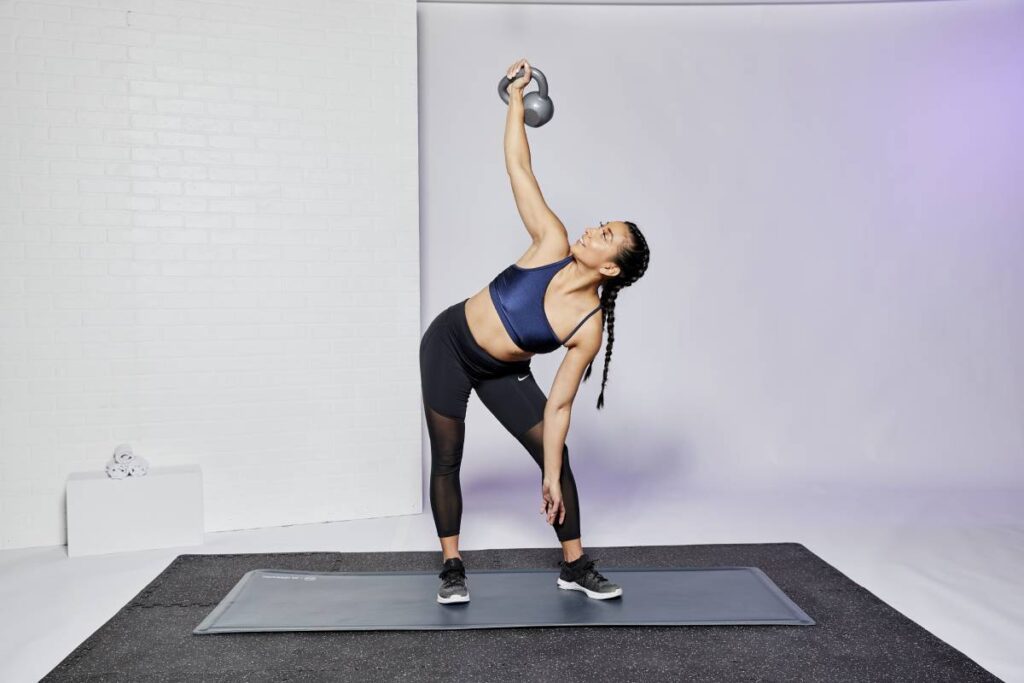
✅ Muscle Imbalances
If you sit at a desk all day long, humble kettlebell sessions can be your best friend. The kettlebell swing benefits for functional fitness are critical in this matter.
Most strength routines focus on the front of your body: chest, abs, quads, etc. That may lead to weak and unbalanced muscles. Posterior chain exercises are good for sedentary people with back pain.
✅ Sports Performance
Kettlebell swings mimic common motions like bending, lifting, swinging, and more. The repeated practice goes on to enhance your sports performance and daily life. An 8-week study finished with substantial gains in grip strength, leg press strength, core strength, aerobic capacity, and dynamic balance.
It failed to improve static balance, body composition, or flexibility. Exercises performed included one- and two-handed swings, snatches, cleans, presses, and TGUs. Keep in mind that to stimulate specific adaptations you need to expose the body to specific demands.
In many cases it is not what exercise you are doing but the way you do it… Exercise selection vs Exercise application.
✅ HIIT Workouts
High-intensity interval training (HIIT) comprises vigorous rounds and short rest periods. It can derive some similar health and performance benefits as moderate-intensity continuous training (MICT), despite less time commitment.
However, most HIIT protocols tend to be high-impact, including exercises like burpees, sprints, box jumps and more . What are kettlebell swings good for?
They can be a good choice for HIIT due to full-body integration, high mechanical demand, and relative safety with proper form.
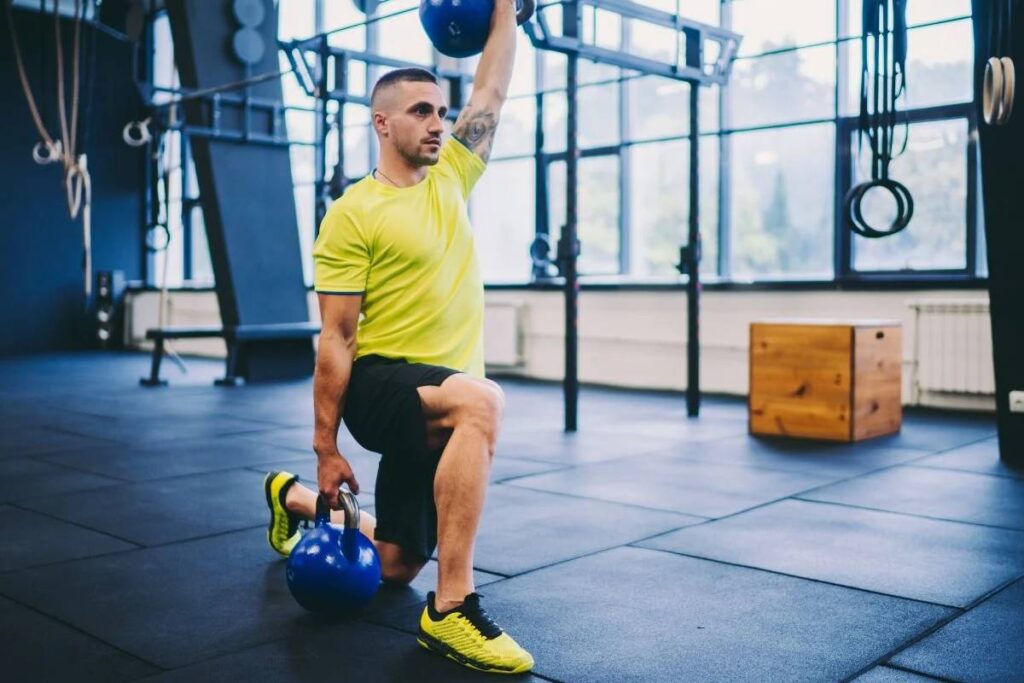
✅ Convenience of No Parallel
Kettlebells are convenient on multiple levels. First, they can tire you out with muscle damage, whopping intensity, and maximal heart rate. Kettlebell workouts last around 10-20 minutes.
Safety risks, required equipment, and the learning curve are lower. A small study equated kettlebell swings with three times heavier deadlifts, according to therapeutic value, calling it a more affordable and appealing option for seniors.
How to Integrate Kettlebell Swings Into Your Routine?
Change management is easier with kettlebells because they can fit in your cardio as well as resistance programs. One thing to look out for is maintaining the proper form. That is crucial to squeeze most KB swings benefits and steer clear of injuries.
1. Steps/Phases to Do
- Stance: Kettlebell swings are among hip hinge movements like deadlifts. Start by standing with your feet shoulder-width apart or a bit more. Then, push back your hips, lowering the torso with a neutral backbone and keeping full feet contact.
- Pick Up: You can practice only this step early on. Keep the bell between your feet or slightly in front of your toes as you pick it up. You must maintain a hinged hip with your upper back and core thoroughly engaged from the word go, leaving the knees little to do.
- Swing: Initiate the swing in the same fashion. As the kettlebell comes out of the knees, push your hips forward and tuck in butts into the standing position. The weight will come up to your shoulder height max. Use your arm strength for gripping, not propelling the bell.
- Return: The gravity does the work downhill. Make sure to slip into hip flexion once again with a proper hinge. It might take a few attempts to find the rhythm. The return part sees minimum activity in the glutes. However, it’s important to control and repeat the movement.
- Repetitions: After the initial pickup, each successive swing and reversal make up one rep. Limit each set to 10 reps. You can customize the length of sets, rest, and entire duration at your will. A total of 3 sets or 5 minutes will suffice in the beginning. If you think it won’t break any sweat, think again!
- Breathing: Regulating the breath is vital to perform exercises correctly, even more so with HIIT. The rule of thumb for KB swings is to inhale at pickup and exhale violently at the top.
- Warm Up: Swings are easier on joints, not always on your muscles and lungs. Going headfirst might take a toll on your physical capabilities. Adding a warm-up is a proven way to rev up nutrient-rich blood supply and body temperature. Do some cardio or light swings at first.
- Shake It Up: The benefits of heavy kettlebell swings are far-reaching and influential on their own. It doesn’t stop you from mixing a few things up. You can do cleans, snatches, presses, Turkish get-ups, and goblet squats with the same kettlebell.
2. Mistakes to Avoid
- Bending Knees before hip hinge for the pickup: Remember, the hip-hinge movement lays the foundation of kettlebell swings. Squatting brings quads into action, changing the desired trajectory.
- “Using” arms: Again, the momentum should come from your lower body, driving the bell up and down with your hamstrings and glutes. Arms are there to grip and guide.
- Bending or extending excessively: Watch out for it at two points: back and knees. Avoid rounding your back. Your spine and shoulders should remain straight, from the sacrum to the skull.
- Ignoring the core: Check out the bracing technique. Abs and lower back are thoroughly engaged with the optimal form. Ignoring the core’s role will disturb the stance and potentially lead to injuries.
- Failing to breathe: Lastly, it might feel urgent to hold the air. But you must keep regulating the breath with every rep. Inhale as you start the swing, and exhale with the push.
3. Variations to Try
- Single-arm KB Swing: You can perform challenging swings with the bell in one arm. Choose a lighter weight, and switch hands after one rep. To keep the body stable and balanced, hold the free hand out to the side.
- American KB Swing: The conventional variation is known as Russian KB swings. There is also an advanced American type where you raise the kettlebell overhead. It needs greater contribution from shoulders.
- Double KB Swing: Doubling the kettlebells places more emphasis on the muscles involved. It can be a game-changer once you’ve aced the early challenge..
- Half Kneeling KB Swing: Do single-arm swings. When resting on the floor with one knee bent at 90 degrees and another touching the ground, your core has to do more work.
- Banded KB Swing: No matter how much you can lift, attaching a resistance band is a surefire recipe to overload. Powerlifters agree! The same can be done with kettlebells, running a loop through its handle.
How to Choose the Best Kettlebell for Swings?
Despite recent experiments and innovations, a kettlebell is one of the simplest weightlifting aids. The proper shape and size is the one that suits you the best, depending on your fitness levels and goals.
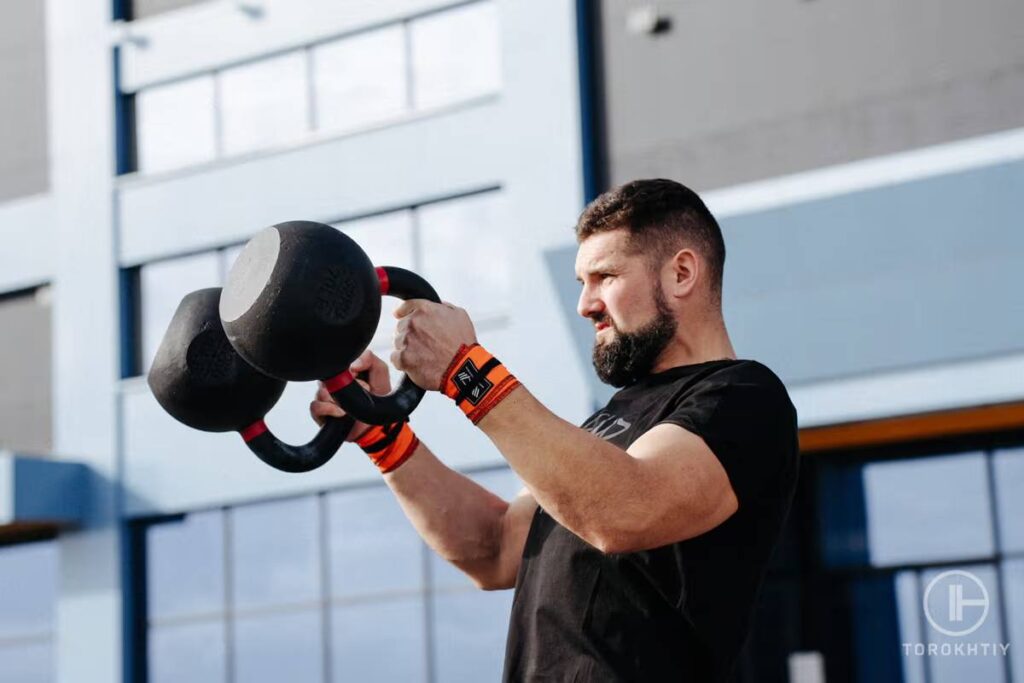
1. Types of Kettlebells
Different varieties of kettlebells may look alike on a rack. But the feel and fit may differ significantly. The old-school cast iron bells with powder or newer e-coatings are still the finest options.
You can have competition sets with a uniform width and size. Adjustable kettlebells allow you to plug or detach increments in a single housing. Don’t buy completely round balls with a sharp handle stuck on the top or dedicated rubber feet at the bottom.
2. Weight Selection
The bottleneck of decision-making is to choose the appropriate weight. You want the lift to be challenging but not impossible. Therefore, start with lighter variants. Once it gets easier, progress to a heavier version.
Or you can decide to jack up the duration of training instead. For kettlebell swings and snatches, 12-18 lb is the beginner level. Over 35 lb and 53 lb are considered as “advanced” for female and male athletes, respectively.
You might usually handle one size smaller for grind exercises (deadlifts, presses, goblet squats, etc.), but that depends on your current fitness level as well.
3. Handle and Grip
Handles are almost similar. Dimensions can make or break the deal. Avoid super thick as well as narrower handles – 1″-1.5″ is the perfect width.
Discard any model with sharp cuts and nicks. Similarly, the spacing must be adequate for both hands. A secure grip demands your fingers to be wrapped on the handle. Throwing a bowling ball flying isn’t unheard of.
Lastly, several slippy and colorful coatings, like plastic and vinyl, will seduce you to save the floor.
Kettlebells We Recommend
Rogue E-Coat Kettlebells are tough and trendy. Available in 12 weight increments from 9-88 lb (4-40 kg), they allow you to customize a set for all your garage gym needs.
Smaller sizes come with a 1.2″ handle dia that swells to just 1.5″ for 35 lb and heavier variants. The ductile iron is more rigid than the usual gray iron we see.
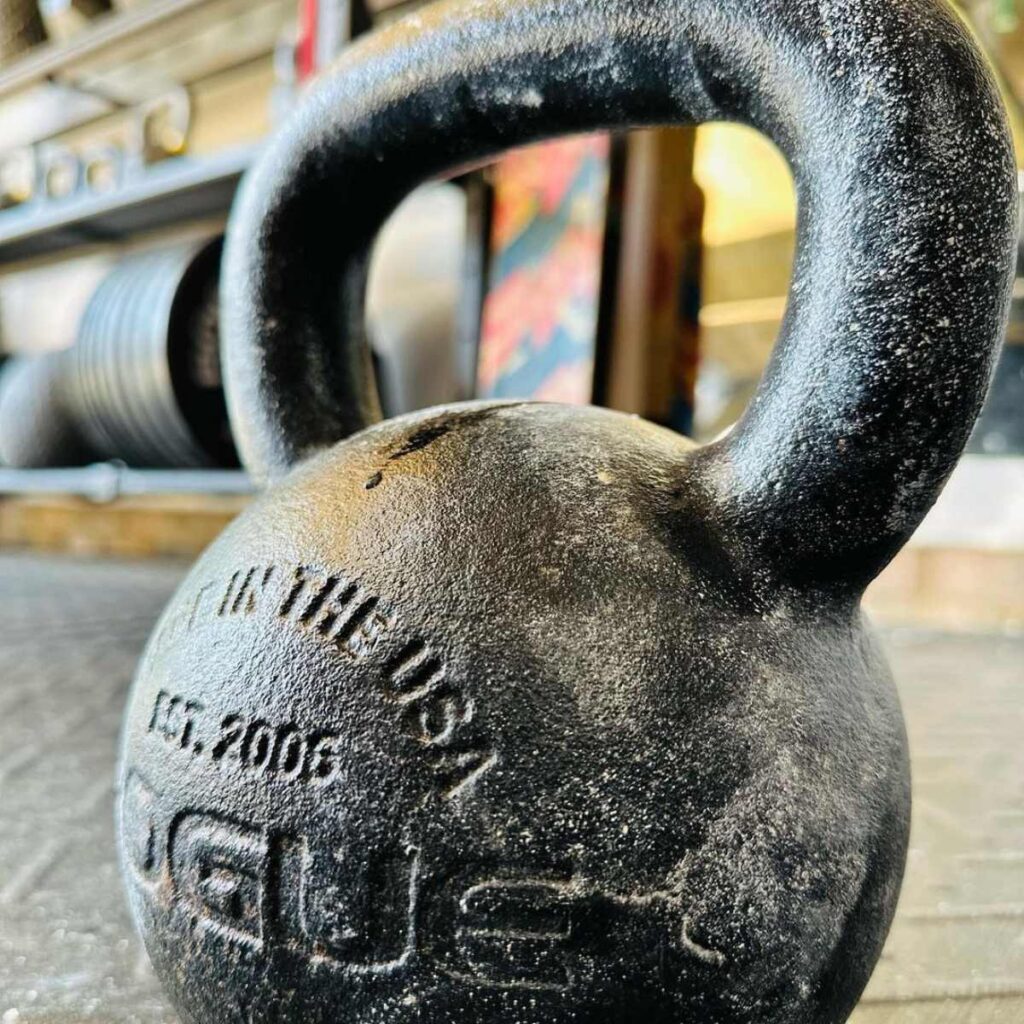
Also, electrically applied paint gives these US-made bells and branding a glossy yet gritty finish that holds chalk as seamlessly as it gets wipe-cleaned.
FAQ
1. What Happens if You Do Kettlebell Swings Every Day?
KB swing can be a low-impact, from low- to high-intensity move that might last for as little as ten minutes. You can perform it every day, depending on the volume, avoiding overtraining. But we’d recommend limiting kettlebell swings to 2 times/week when starting out. Later, add more of these into your routine if you want.
2. What Happens if You Do 100 Kettlebell Swings a Day?
As usual 🙂 it depends… On your fitness level, timeframe of that challenge, weight used, rest time and more… One hundred reps is a lot for any exercise.
Depending on the intensity, if you do 100 KB swings everyday for a week or two non-stop, you can surely improve your aerobic and/or anaerobic systems.
On the other hand, getting overuse injuries or blisters are common side effects of this challenge. What matters is you keep the form correct and avoid overtraining.
Consult a personal trainer. You can try variations, such as single-arm and American kettlebell swings, as a substitute for increasing reps.
3. Will Kettlebell Swings Burn Belly Fat?
Staying in the kcal deficit is the key to weight loss. So, there are two sides of the coin: diet and workout. Kettlebell swings can be a great calorie burner. They shouldn’t be a mainstay in your fat loss regime but can certainly help in scorching belly fat.
Performing walks and KB swings can have net positive effect on obese people. Additionally, you can’t highlight specific body parts to remove fat. It’s a holistic process that occurs bodywide.
Conclusion
There are tons of benefits of kettlebell swings for your endurance, strength, and balance. This dynamic power move wakes up a plethora of muscles with its single blow, allowing you to burn a lot of calories in a short amount of time. A swing is perhaps all you need to break into at-home fitness or spice up your current regime.
Ego lifting is quick to devastate kettlebell workouts. The benefits of heavy kettlebell swings are only guaranteed when you do them with a proper form.
Have you done KB swings? What’s your PR so far? The comment section is for you to flaunt. Any suggestions and queries are also welcomed.
Also read:
- Best Adjustable Kettlebells
- What Muscles Do Kettlebell Swings Work
- Kettlebell Core Workout
- Kettlebell Leg Workout
- Beginner Kettlebell Workout
References
- Michael J Del Monte et al., “Hamstring Myoelectrical Activity During Three Different Kettlebell Swing Exercises,” J Strength Cond Res. 2020 Jul;34(7):1953-1958
- Erbes, Dustin A., “The effect of kettlebell training on body composition, flexibility, balance, and core strength,” Part of UW-L Theses & Dissertations
- Andersen, Vidar et al., “Core Muscle Activation in One-Armed and Two-Armed Kettlebell Swing,” Journal of Strength and Conditioning Research 30(5):p 1196-1204
- Nicholas A Levine et al., “Effects of kettlebell mass on lower-body joint kinetics during a kettlebell swing exercise,” Sports Biomech. 2022 Oct;21(9):1032-1045
- Neil J. Meigh et al., “Kettlebell training in clinical practice: a scoping review,” BMC Sports Sci Med Rehabil. 2019; 11: 19
- Schoenfeld, Brad J, “The Mechanisms of Muscle Hypertrophy and Their Application to Resistance Training,” Journal of Strength and Conditioning Research 24(10):p 2857-2872, October 2010.
- Lake, Jason P. and Lauder, Mike A., “Kettlebell Swing Training Improves Maximal and Explosive Strength,” Journal of Strength and Conditioning Research 26(8):p 2228-2233
- Rodrigo Luiz Vancini et al., “Kettlebell Exercise as an Alternative to Improve Aerobic Power and Muscle Strength,” J Hum Kinet. 2019 Mar; 66: 5–6
- Hulsey, Caleb R. et al., “Comparison of Kettlebell Swings and Treadmill Running at Equivalent Rating of Perceived Exertion Values,” Journal of Strength and Conditioning Research 26(5):p 1203-1207
- McGill, Stuart M. and Marshall, Leigh W., “Kettlebell Swing, Snatch, and Bottoms-Up Carry: Back and Hip Muscle Activation, Motion, and Low Back Loads,” Journal of Strength and Conditioning Research 26(1):p 16-27
Why Trust Us?
With over 20 years in Olympic Weightlifting, our team does its best to provide the audience with ultimate support and meet the needs and requirements of advanced athletes and professional lifters, as well as people who strive to open new opportunities and develop their physical capabilities with us.
By trusting the recommendations of our certified experts in coaching, nutrition, dietology, and sports training programming, as well as scientific consultants, and physiotherapists, we provide you with thorough, well-considered, and scientifically proven content. All the information given in the articles concerning workout programming, separate exercises, and athletic performance, in general, is based on verified data. We ensure that you can rely on our professionals’ pieces of advice and recommendations that can be treated as personalized ones which will benefit you and fully meet your needs.
The product testing process is described in more detail here
Author: Ihor Shymechko
Pro Olympic Weightlifter, Coach
Best Results: Snatch – 208 kg,
C&J – 240 kg
Ihor has been a professional weightlifter since 1996, boasting over two decades of competition experience. His notable achievements include clinching the European Championship in 2009 and securing a silver medal in the 105kg division at the Senior World Championships in 2011. Ihor represented his country in the 2008, 2012, and 2016 Summer Olympics. After retiring from competitive weightlifting, he transitioned to coaching, leveraging his vast experience to guide athletes who now compete on both national and international stages.

